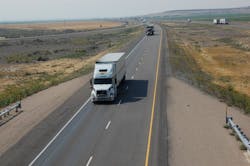So by now you’ve probably heard more about electronic logging devices (ELDs) and their mandated use by the trucking industry than you’d ever want to know – especially since that mandate fully goes into effect in December 2017, almost two years away.
Yet more than a few folks think taking your time complying with the ELD rule is a bad idea – largely many shippers seem to be taking a very proactive stance in terms of working only with ELD-compliant fleets.
“Some shippers are stepping up as they ask carriers to begin installing ELDs now,” noted John Larkin, managing director and head of transportation capital markets research at Stifel Financial Corp., during a speech last week at the 2016 Truckload Carriers Association (TCA) annual meeting in Las Vegas.“Some shippers have decided that it is too risky to wait until the middle of December 2017 to see if core carriers have sufficiently progressed in installing ELDs as those carriers who have not completed installation by mid-December 2017 would be considered non-compliant,” he stressed.
“Most shippers have little interest in using non-compliant carriers,” Larkin added. “We mention this fairly widespread trend to suggest that the impact associated with ELD implementation may be felt a little earlier than some had projected.”
And that “impact” may be pretty severe, especially where small carriers are concerned. (Go here and here for more details on that unsettling trend)
But if you don’t have ELDs in your fleet right now – and Stifel estimates that 50% of the industry doesn’t – how do you go about it?
Skip Kinford, president and CEO of MiX Telematics America, recently put together some guidance to help direct those fleets currently without ELDs on how to go about adopting them:
- Remember the timeline: According to the long-awaited ELD mandate Final Rule, motor carriers without a current solution in place now have until December 2017 to implement ELDs for any vehicle or combination of vehicles with an actual weight and/or gross vehicle weight rating (GVWR) of 10,001 lbs. or more. Incidentally, the Federal Motor Carrier Safety Administration (FMCSA) believes the trucking industry should gain a “net annual benefit” of more than $1 billion by adopting ELDs, largely by reducing the amount of required industry paperwork. The agency also predicts those devices will help save 26 lives annually and prevent 562 injuries resulting from crashes involving large commercial motor vehicles.
- There is a grandfather clause: Many fleets are already ahead of the game, Kinford noted, having installed automatic onboard recording devices or (AOBRDs) to track hours of service (HOS) information while eliminating paper logbooks. The ELD rule will grandfather in AOBRDs, allowing for their continued use until December 2019, he noted.
- ELD Vendors will still self-report their compliance with FMCSA ELD regulations: “FMCSA is not vetting vendor solutions; vendor ELD compliance is self-reported and interpretation may vary by vendor,” Kinford stressed. As a result, the FMCSA is expected to provide a certification test for vendors in the coming months that will ensure vendors meet the technical requirements established for ELD devices. That should help establish which vendors are truly compliant with the rules, he said.
- Fleets should test prospective ELD solutions using their own fleet data to make sure the platform will work for them: “Make sure when you test devices, you are fully aware of capabilities of the in-cab driver interface as well as the management interface,” Kinford pointed out. “In most cases, company management personnel will spend the majority of time using the management interface, specifically when monitoring HOS compliance internally.”
- Ask vendors what process they will go through to keep their systems up to date with current FMCSA rules: Some ELD vendors require physical visits to each and every vehicle in order to make updates, while others can update their systems in minutes over the air. “Obviously the latter method is easier and less expensive and least likely to put your fleet out of compliance when there are updates required,” Kinford said. “Fleet managers should also check to make sure installations and updates are included in their maintenance contracts.”
- Make sure you know what you’re getting yourself into: “There are several low-end, ELD-only tools now being sold,” Kinford noted. “They are scoped very tightly to provide minimum compliance, with no opportunity to upgrade later to take advantage of features such as tracking driver behavior, fleet optimization, fuel optimization, in-cab driver coaching or navigation.” Thus if a fleet decides it wants extra features, it must replace such devices, he said. “So if you don’t already have an ELD system in place, take the time to evaluate what other technology your fleet may be lacking – you don’t want to go through this process more than once.”
- Don’t wait too long to take action: MiX believes 75% of fleets don’t currently have an AOBRD or electronic onboard recorder (EOBR) device in their trucks – and that means there could be an installation “logjam” if carriers delay the adoption process too long. “The FMCSA final rule is very clear; with limited exceptions, fleets need to start using ELDs or they will be fined,” Kinford said.
- There is a business case to be made: Kinford strongly believes there is a “business case” to be made for ELDs in terms of reducing fleet costs; thus the sooner fleets implement them, the sooner they can gain such savings. “The business case for implementing ELDs is also very clear and it’s driven by safety and economics,” he said. “Fleets that implement ELDs have fewer accidents, eliminate most paperwork, reduce their fuel costs by 10% on average, and run much more efficiently. Full-featured ELDs typically pay for themselves within a few months.”
That’s a lot to chew on. But chew on it fleets must in order to be ready when ELD “hammer time” rolls around in December 2017.

